12 start with D start with D
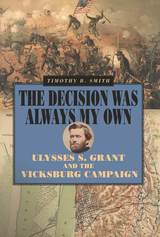
Showing how and why Grant became such a successful general, Smith presents a fast-paced reexamination of the commander and the campaign. His fresh analysis of Grant’s decision-making process during the Vicksburg maneuvers, battles, and siege details the course of campaigning on military, political, administrative, and personal levels. The narrative is organized around Grant’s eight key decisions: to begin operations against Vicksburg, to place himself in personal charge of the campaign, to begin active operations around the city, to sweep toward Vicksburg from the south, to march east of Vicksburg and cut the railroad before attacking, to assault Vicksburg twice in an attempt to end the campaign quickly, to lay siege after the assaults had failed, and to parole the surrendered Confederate garrison rather than send the Southern soldiers to prison camps.
The successful military campaign also required Grant to master political efforts, including handling Lincoln’s impatience and dealing with the troublesome political general John A. McClernand. Further, he had to juggle administrative work with military decision making. Grant was more than a military genius, however; he was also a husband and a father, and Smith shows how Grant’s family was a part of everything he did.
Grant’s nontraditional choices went against the accepted theories of war, supply, and operations as well as against the chief thinkers of the day, such as Henry Halleck, Grant’s superior. Yet Grant pulled off the victory in compelling fashion. In the first in-depth examination in decades, Smith shows how Grant’s decisions created and won the Civil War’s most brilliant, complex, decisive, and lengthy campaign.
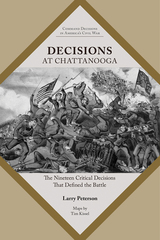
Decisions at Chattanooga introduces readers to critical decisions made by Confederate and Union commanders. Larry Peterson examines the decisions that shaped the way both campaign and battle unfolded. Rather than offering a history of the Battle of Chattanooga, Peterson focuses on the critical decisions, presenting the reader with a coherent and manageable blueprint of the battle’s development. Exploring and studying the critical decisions allows the reader to progress from an understanding of what happened to why events happened as they did.
Complete with maps and a guided tour, Decisions at Chattanooga is an indispensable primer, and readers looking for a digestible introduction to the Battle of Chattanooga can tour this sacred ground—or read about it at their leisure—with key insights into the campaign and a deeper understanding of the Civil War itself.
Decisions at Chattanooga is the fourth in a series of books that will explore the critical decisions of major campaigns and battles of the Civil War.

In the fall of 1862, after a leadership shake-up initiated by Lincoln, Gen. Ambrose Burnside assumed command of the Army of the Potomac and developed an aggressive plan to attack the Confederate capital of Richmond. However, in order to reach Richmond, Burnside had to march through Fredericksburg, where Gen. Robert E. Lee’s Army of Northern Virginia was well entrenched. After crossing the Rappahannock River under enemy fire, Burnside and his troops engaged Lee’s army within the city, then launched a futile frontal assault against a heavily fortified ridge west of Fredericksburg. The end result was a decisive victory for the Confederacy, as the Union army suffered more than double the number of casualties as its foes. Burnside would resign a month later but would resurface as war in the Western Theater grew heated.
Decisions at Fredericksburg explores the critical decisions made by Confederate and Union commanders during the battle and how these decisions shaped its outcome. Rather than offering a history of the battle, Chris Mackowski hones in on a sequence of critical decisions made by commanders on both sides of the contest to provide a blueprint of the Battle of Fredericksburg at its tactical core. Identifying and exploring the critical decisions in this way allows students of the battle to progress from knowledge of what happened to a mature grasp of why events happened.
Complete with maps and a driving tour, Decisions at Fredericksburg is an indispensable primer, and readers looking for a concise introduction to the battle can tour this sacred ground—or read about it at their leisure—with key insights into the campaign and a deeper understanding of the Civil War itself.
Decisions at Fredericksburg is the eleventh in a series of books that will explore the critical decisions of major campaigns and battles of the Civil War.
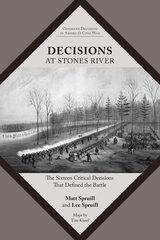
From December 31, 1862, to January 2, 1863, the Army of the Cumberland and Army of Tennessee fought a bloody battle along Stones River. Led by Major General William S. Rosecrans, Union forces would eventually emerge victorious. Coming at the end of a series of Union defeats, this victory would give Lincoln and the Northern population a bright ray of hope during a fall and winter of reversals.
Decisions at Stones River introduces readers to critical decisions made by Confederate and Union commanders. Matt Spruill and Lee Spruill examine the decisions that shaped the way the campaign and battle unfolded. Rather than offering a history of the Battle of Stones River, the Spruills focus on the critical decisions, those decisions that had a major impact on both Federal and Confederate forces in shaping the progression of the battle as we know it today. This account is designed to present the reader with a coherent and manageable blueprint of the battle’s development. Exploring and studying the critical decisions allows the reader to progress from an understanding of “what happened” to “why events happened” as they did.
Complete with maps and a guided tour, Decisions at Stones River is an indispensable primer, and readers looking for a digestible introduction to the Battle of Stones River can tour this sacred ground—or read about it at their leisure—with key insights into why events unfolded as they did and a deeper understanding of the Civil War itself.
Decisions at Stones River is the first in a series of books that will explore the critical decisions of major campaigns and battles of the Civil War
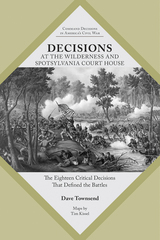
The successive battles of The Wilderness and Spotsylvania Court House opened Lt. Gen. Ulysses S. Grant’s 1864 Overland Campaign. As the first confrontation between Union and Confederate leaders Grant and Gen. Robert E. Lee, these two bloody battles signaled the new reality of war. The fighting at the Battle of The Wilderness, immediately followed by the Battle of Spotsylvania Court House, was costly for both sides, and while the Union army could replace its losses, Lee’s Army of Northern Virginia could not. It would be exactly one year from Grant’s orders to Gen. George G. Meade stating that Lee’s army would be his objective until the surrender at Appomattox.
Decisions at The Wilderness and Spotsylvania Court House introduces readers to critical decisions made by Confederate and Union commanders throughout the two costly meetings. Dave Townsend examines the decisions that prefigured the action and shaped the course of each battle as it unfolded. Rather than a linear history of the battles, Townsend’s discussion of the critical decisions presents readers with a vivid blueprint of the battles’ developments. Exploring the critical decisions in this way allows the reader to progress from a sense of what happened in these battles to why they happened as they did.
Complete with maps and a guided tour, Decisions at The Wilderness and Spotsylvania Court House is an indispensable primer, and readers looking for concise introductions to the battles can tour this sacred ground—or read about it at their leisure—with key insights into the battles and a deeper understanding of the Civil War itself.
Decisions at The Wilderness and Spotsylvania Court House is the seventh in a series of books that will explore the critical decisions of major campaigns and battles of the Civil War.
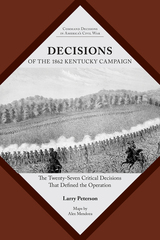
Decisions of the 1862 Kentucky Campaign introduces readers to critical decisions made by Confederate and Union commanders throughout the heartland contest. Rather than offering a history of the Kentucky Campaign, Larry Peterson hones in on a sequence of critical decisions confronting commanders on both sides of the clash to provide a blueprint of the campaign at its tactical core. Identifying and exploring the critical decisions in this way allows students of history to go from a rudimentary sense of the what of warfare, to a mature grasp of why.
Complete with maps and a guided tour, Decisions of the 1862 Kentucky Campaign is an indispensable primer, and readers looking for a digestible introduction to the campaign’s battles can tour this sacred ground—or read about it at their leisure—with key insights into the campaign and a deeper understanding of the Civil War itself.
Decisions of the 1862 Kentucky Campaign is the sixth in a series of books that will explore the critical decisions of major campaigns and battles of the Civil War.
LARRY PETERSON retired from United Airlines as a Boeing 757/767 Standard Captain. He is the author of Confederate Combat Commander: The Remarkable Life of Brigadier General Alfred Jefferson Vaughn Jr. and Decisions at Chattanooga.
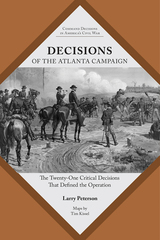
Decisions of the Atlanta Campaign introduces readers to critical decisions made by Confederate and Union commanders throughout that tide-turning summer of 1864. Rather than offering a history of the Atlanta Campaign, Larry Peterson hones in on a sequence of critical decisions confronting commanders on both sides of the clash to provide a blueprint of the campaign at its tactical core. Identifying and exploring the critical decisions in this way allows students of the campaign to progress from a rudimentary sense of the what of warfare, to a mature grasp of why.
Complete with maps and a guided tour, Decisions of the Atlanta Campaign is an indispensable primer, and readers looking for a digestible introduction to the Battle of Chattanooga can tour this sacred ground—or read about it at their leisure—with key insights into the campaign and a deeper understanding of the Civil War itself.
Decisions of the Atlanta Campaign is the fifth in a series of books that will explore the critical decisions of major campaigns and battles of the Civil War.
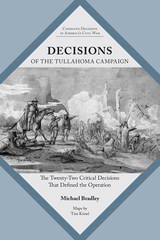
The Tullahoma Campaign took place in Middle Tennessee, setting Union General William S. Rosecrans’s Army of the Cumberland against Confederate General Braxton Bragg’s Army of Tennessee. Rosecrans’s objective was to force the Confederate Army to vacate Middle Tennessee and put pressure on Chattanooga. Through a series of maneuvers, rather than battles, he achieved his goal; however, Union victories at Vicksburg and Gettysburg would overshadow his success.
Decisions of the Tullahoma Campaign introduces readers to critical decisions made by Confederate and Union commanders throughout that eventful summer of 1863. Rather than offering a history of the Tullahoma Campaign, Michael R. Bradley hones in on a sequence of critical decisions confronting commanders on both sides of the clash to provide a blueprint of the campaign at its tactical core. Identifying and exploring the critical decisions in this way allows students of the campaign to progress from a rudimentary sense of the what of warfare, to a mature grasp of why.
Complete with maps and a driving tour, Decisions of the Tullahoma Campaign is an indispensable primer, and readers looking for a concise introduction to the Tullahoma Campaign can tour this sacred ground—or read about it at their leisure—with key insights into the campaign and a deeper understanding of the Civil War itself.
Decisions of the Tullahoma Campaign is the eighth in a series of books that will explore the critical decisions of major campaigns and battles of the Civil War.
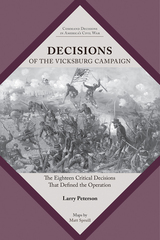
Decisions of the Vicksburg Campaign explores the critical decisions made by Confederate and Federal commanders during the battle and how these decisions shaped its outcome. Rather than offering a history of the battle, Larry Peterson hones in on a sequence of critical decisions made by commanders on both sides of the contest to provide a blueprint of the battles for Vicksburg at their tactical core. Identifying and exploring the critical decisions in this way allows students of the battles to progress from a knowledge of what happened to a mature grasp of why events unfolded as they did.
Complete with maps and a driving tour, Decisions of the Vicksburg Campaign is an indispensable primer, and readers looking for a concise introduction to the battle can tour this sacred ground—or read about it at their leisure—with key insights into the campaign and a deeper understanding of the Civil War itself. Decisions of the Vicksburg Campaign is the twentieth in a series of books that will explore the critical decisions of major campaigns and battles of the Civil War.
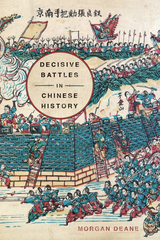
“If you know the enemy and know yourself, you need not fear the result of a hundred battles. If you know yourself but not the enemy, for every victory gained you will also suffer a defeat. If you know neither the enemy nor yourself, you will succumb in every battle.”― Sun Tzu, The Art of War
The study of Chinese battles faces many hurdles that include different spelling systems, a haze of seemingly impenetrable names, places, and ideas, and different approaches to recording history. Early indigenous Chinese histories were written by Confucians with an antimilitary bias, and used rather laconic phrases to describe battles. These accounts were then transmitted to Jesuit missionaries who shared the Confucian disdain for martial matters. The modern discipline of history developed in the West during a time of particular Chinese weakness and political division, resulting in the lack of parallel material. Decisive Battles in Chinese History by Morgan Deane overcomes these obstacles to present the vast span of recorded Chinese history through key battles, from Maling, fought in 342 BC during the Warring States period, to Hengyang in 1944, which marked the end of major Japanese operations in China. Each of the twelve chapters highlights a significant conflict that selectively focuses on unique Chinese characteristics of the time, including belief systems, ruling ideology, the connection between technology and warfare, military theory, political events and rulers, and foreign policy, including China’s eventual interaction with the West. The book pushes back on a variety of ideas and stereotypes, ranging from the Chinese use of gunpowder, their supposedly weak reaction to the West, the viability of the Dynastic Cycle in studying history, the context of Chinese military theory, the exclusivity of martial and cultural spheres, and the uniqueness of Western imperialism. It also offers a groundbreaking reassessment of Mao Zedong’s leadership and his impact on the development of guerilla warfare. In a world filled with disturbing reports of conflict and potential warfare, Decisive Battles in Chinese History offers a unique addition to students, historians, and general readers wishing to better understand Chinese history.
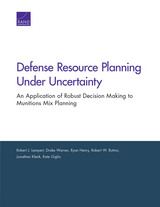

READERS
Browse our collection.
PUBLISHERS
See BiblioVault's publisher services.
STUDENT SERVICES
Files for college accessibility offices.
UChicago Accessibility Resources
home | accessibility | search | about | contact us
BiblioVault ® 2001 - 2024
The University of Chicago Press









